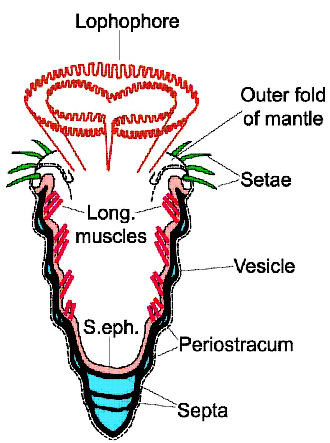 This may look like just another wormtube on a shell — a recurring theme on this blog — but it is special, of course. This is the common Paleozoic genus Cornulites Schlotheim 1820, specifically Cornulites flexuosus (Hall 1847). It was found in the Whitewater Formation (Upper Ordovician) during a College of Wooster field trip to southeastern Indiana.
This may look like just another wormtube on a shell — a recurring theme on this blog — but it is special, of course. This is the common Paleozoic genus Cornulites Schlotheim 1820, specifically Cornulites flexuosus (Hall 1847). It was found in the Whitewater Formation (Upper Ordovician) during a College of Wooster field trip to southeastern Indiana.
 Above is a larger view of the substrate for this wormtube: the ventral valve exterior of a strophomenid brachiopod. If you look closely at the costae (fine radiating lines) of the brachiopod you can see that it was alive when the cornulitid landed on its shell. As both animals continued to grow, the wormtube bent toward the commissure (opening) of the brachiopod, no doubt to snatch some suspended food from its feeding current. The cornulitid was thus a parasite on the host brachiopod. (See Morris and Rollins, 1971; Vinn and Mutvei, 2005; and Vinn and Wilson, 2010, for much more detail on cornulitid paleoecology.)
Above is a larger view of the substrate for this wormtube: the ventral valve exterior of a strophomenid brachiopod. If you look closely at the costae (fine radiating lines) of the brachiopod you can see that it was alive when the cornulitid landed on its shell. As both animals continued to grow, the wormtube bent toward the commissure (opening) of the brachiopod, no doubt to snatch some suspended food from its feeding current. The cornulitid was thus a parasite on the host brachiopod. (See Morris and Rollins, 1971; Vinn and Mutvei, 2005; and Vinn and Wilson, 2010, for much more detail on cornulitid paleoecology.)
Cornulitids (Ordovician – Carboniferous) belong to a large group of tube-dwelling organisms that, surprisingly, may be closely related to brachiopods and bryozoans. Cornulitids, along with fellow tube-dwellers the microconchids, tentaculitids and hederelloids, have a foliated shell ultrastructure with various other features indicating they may be part of a larger group called the lophophorates (see Taylor et al., 2010). Much work still needs to be done on their systematics and paleoecology to sort out the evolutionary relationships here, but we have a good start.
 The genus Cornulites was described and named by Ernst Friedrich, Baron von Schlotheim (1764-1832), a German palaeontologist and politician born in Almenhausen, Thuringia, Germany. As a noble, he was home-schooled (as we’d say now) and then sent to the Gymnasium (like a high school) in Gotha, Germany. After graduation, he attended Göttingen where he studied political administration and the natural sciences with Johann Friedrich Blumenbach. He enjoyed geology very much and so went off to Freiburg to learn from the famous Abraham Gottlob Werner of Neptunist fame. One of his friends was the scientist-explorer Alexander von Humboldt. After this extraordinary education, Schlotheim entered the civil service in Gotha in 1792, eventually rising all the way up to Lord High Marshal a few years before his death. During his administrative work, though, he continued serious paleontological studies, being one of the first paleontologists to use Linnean binomial nomenclature, making fossils much more useful for stratigraphy and later evolutionary studies. Schlotheim had some very progressive ideas about what we would later call uniformitarianism, and he recognized that geology could tell a history of the Earth quite different from that outlined by theological scholars.
The genus Cornulites was described and named by Ernst Friedrich, Baron von Schlotheim (1764-1832), a German palaeontologist and politician born in Almenhausen, Thuringia, Germany. As a noble, he was home-schooled (as we’d say now) and then sent to the Gymnasium (like a high school) in Gotha, Germany. After graduation, he attended Göttingen where he studied political administration and the natural sciences with Johann Friedrich Blumenbach. He enjoyed geology very much and so went off to Freiburg to learn from the famous Abraham Gottlob Werner of Neptunist fame. One of his friends was the scientist-explorer Alexander von Humboldt. After this extraordinary education, Schlotheim entered the civil service in Gotha in 1792, eventually rising all the way up to Lord High Marshal a few years before his death. During his administrative work, though, he continued serious paleontological studies, being one of the first paleontologists to use Linnean binomial nomenclature, making fossils much more useful for stratigraphy and later evolutionary studies. Schlotheim had some very progressive ideas about what we would later call uniformitarianism, and he recognized that geology could tell a history of the Earth quite different from that outlined by theological scholars.
Here’s to the intellectual innovations and courage of Baron von Schlotheim and the little fossil wormtube that reminds us of him!
References:
Morris, W. R., and H. B. Rollins. 1971. The distribution and paleoecological interpretation of Cornulites in the Waynesville Formation (Upper Ordovician) of southern Ohio. The Ohio Journal of Science 71: 159-170.
Schlotheim, E.F. von. 1820. Die Petrefakten-Kunde auf ihrem jetzigen Standpunkte durch die Beshreibung seiner Sammlung versteinerter und fossiler Ueberreste des their-und Planzenreichs der Vorwelt erlaeutert. Gotha, 437 p.
Taylor, P.D., Vinn, O. and Wilson, M.A. 2010. Evolution of biomineralization in ‘lophophorates’. Special Papers in Palaeontology 84: 317-333.
Vinn, O. and Mutvei, H. 2005. Observations on the morphology and affinities of cornulitids from the Ordovician of Anticosti Island and the Silurian of Gotland. Journal of Paleontology 79: 726-737.
Vinn, O. and Wilson, M.A. 2010. Abundant endosymbiotic Cornulites in the Sheinwoodian (Early Silurian) stromatoporoids of Saaremaa, Estonia. Neues Jahrbuch für Geologie und Paläontologie 257: 13-22.




Pingback: Wooster Geologists » Blog Archive » Wooster’s Fossil of the Week: An asteroid trace fossil from the Devonian of northeastern Ohio